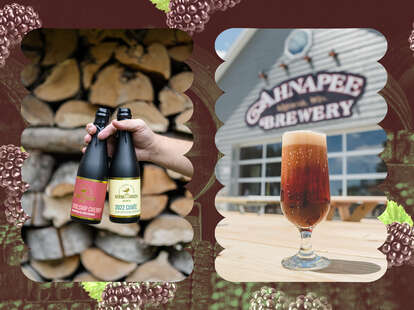
Design by Maitane Romagosa for Thrillist
Jimmy Mauric, head brewmaster of Shiner Beer, has loved dewberries since he was a kid. “They were very abundant and grew wild on fence lines, creek bottoms and railroad track ditches,” says Mauric, who used to forage for the berries, which are related to blackberries, in his hometown of Shiner, Texas. “These berries were a treat to snack on, and most important was the dewberry cobblers and ice cream Momma made out of them.”
When he and his team at Shiner Beer were trying to think of new flavors and styles with a strong sense of place, he kept coming back to those foraged dewberries.
“Nothing gets more local than dewberries,” says Mauric. “They’re literally in our backyards. So, when we were developing the Weisse N Easy in our pilot brewery, we just went out in the country and picked enough dewberries for the brew.”
Easier said than done. Several issues including seasonal variability came to light during the production process. Shiner had to find a larger source to keep the product consistent and profitable. “We can spend so much time picking dewberries. With the volumes we need, we have to outsource larger quantities. We approached Brazos River Provisions, and they were able to supply our needs just a little over 50 miles away from our brewery.”
Shiner is one of several breweries across the U.S. that are using local and seasonal ingredients like dandelions, dewberries, and elderberries to make their beers. But there are all sorts of challenges, brewers say, to incorporating responsibly foraged ingredients in consistent ways and on a large scale.

Foraging for ingredients has been a part of beer-making for centuries, with some historians theorizing that fermentation was discovered while foraging for wild cereals during the Epipaleolithic age. Gruit, one of the first beers in Europe in the Middle ages, was full of foraged plants like bog myrtle, yarrow, marsh rosemary, and heather. A long-standing tradition among Indigenous communities and cultures around the world, foraging has more recently emerged as an industry trend, according to food and beverage analysts. Increasingly, they say, home cooks eager to connect with their food sources and the outdoors have embraced the activity.
Nick Callaway, owner of Ahnapee Brewery in Algoma, Wisconsin, started foraging due to his desire to spend time outdoors with his brother. One spring, when they were out foraging for mushrooms, he had an idea to add morels to the brown ale that was in process at the brewery. That beer, Fun Guy, was released in 2015 and became so much of a hit that it has been in their seasonal rotation ever since.
As he worked through the first 100-gallon batch, Callaway quickly discovered multiple challenges of brewing with foraged mushrooms.
“Our first batch was dry-hopped with mushrooms. When you’re picking stuff from the ground, you’re washing it as well as you can, but it’s from the ground,” he says of the need for thoroughly cleaned ingredients.
Consistency was another concern. “Those mushrooms you picked up today? They will have some amount of moisture in it. Two days later, you may go pick more, and they won’t have the same amount of moisture.”
Callaway ended up working with a local supplier to source Wisconsin-grown mushrooms and shifting his brewing process to add them at the end of the boil rather than during dry-hopping. That way, he could ensure that they were fully sanitized.
In Brattleboro, Vermont, Hermit Thrush Brewery production manager and brewer Nate Scull and his team consider themselves stewards of nature through their beer. Since its founding in 2014, the brewery has specialized in barrel-aged and kettle-soured beers, and has used yeast that was collected from the wild.

“Some of the beers that we brew are foraged from orchards, [others] stream side, and sometimes we just open the door at the cellars facility and we do a coolship, which is a way to harvest wild yeast,” Scull says. He then adds it to the word, or unfermented beer, for a truly unique flavor that only nature can create. “It’s purely harvested off the wind. It’s not just using wild ingredients, but it’s using wild-harvested biology.”
One of the biggest challenges for forging is not just scalability, Scull says, but also how you harvest. “If wild harvesting can’t be done ethically, it doesn’t work for brewing beer.”
Foraging involves ethics, including a code of conduct that says you shouldn’t take more than 10% of what you find. “Otherwise, you’re going to be wiping out a crop of something they need; they have a right to exist, too,” says Scull of wild ecosystems.” So finding the right amount to use or the adequate amount to use an ethically harvesting it can be a challenge.”
Another challenge of brewing with wild ingredients is an occasional lack of laboratory information. There might not be any applicable literature on these wild ingredients, Scull says, or all you can find is outdated information from the 18th century.
“So, you really have to experiment, and there are risks incurred in that,” Scull says. “You don’t know if this ingredient, when it’s boiled, makes a really astringent taste or a really beautiful taste.” Plus, some plants can affect the bacteria and, if used incorrectly, cause their beer not to be sour.
As a result, the Hermit Thrush team thoroughly researches each ingredient and produces its beers made with foraged ingredients in small batches.
For foraging brewers, it’s worth the extra effort to create beers with strong ties to their places of origin. These beers are special even if it requires more legwork to produce them—or, in some cases, especially due to the additional work they require.
“Let me tell you, it’s just so much fun to forage,” Scull says. “When we get to forage spruce tips for a beer, it just feels like a holiday.”
Stephanie Gravalese is a contributor to Thrillist.